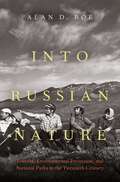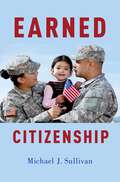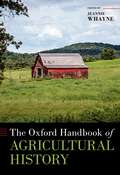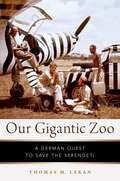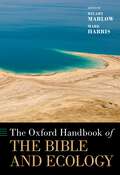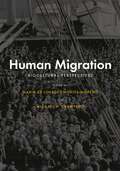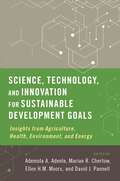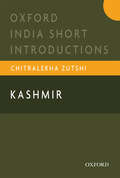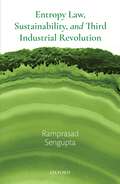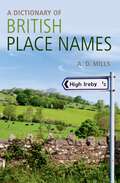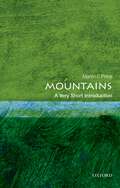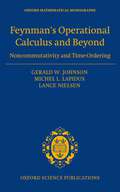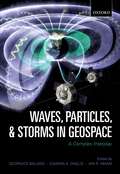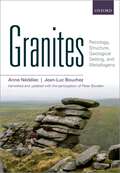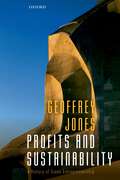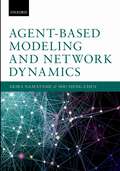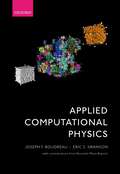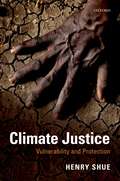- Table View
- List View
Into Russian Nature: Tourism, Environmental Protection, and National Parks in the Twentieth Century
by Alan D. RoeSince the early twentieth century, nations around the world have set aside protected areas for tourism, recreation, scenery, wildlife, and habitat conservation. In Russia, biologists and geographers had been intrigued with the idea of establishing national parks before the Revolution, but instead persuaded the government successfully to establish nature reserves (zapovedniki) for scientific research during the USSR's first decades. However, as the state pushed scientists to make zapovedniki more useful during the 1930s, some of the system's staunchest defenders started supporting tourism in them. In Into Russian Nature, Alan D. Roe offers the first history of the Russian national park movement. In the decades after World War II, the USSR experienced a tourism boom and faced a chronic shortage of tourism facilities. During these years, Soviet scientists took active part in Western-dominated international environmental protection organizations and enthusiastically promoted parks for the USSR as a means to expand recreational opportunities and reconcile environmental protection and economic development goals. In turn, they hoped they would bring international respect to Soviet nature protection efforts and help instill in Russian/Soviet citizens a love for the country's nature and a desire to protect it. By the end of the millennium, Russia had established thirty-five parks to protect iconic landscapes in places such as Lake Baikal. Meanwhile, national park opponents presented them as an unaffordable luxury during a time of economic struggle, especially after the USSR's collapse. Despite unprecedented collaboration with international organizations, Russian national parks received little governmental support as they became mired in land-use conflicts with local populations. Exploring parks from European Russia to Siberia and the Far East, Into Russian Nature narrates efforts, often frustrated by the state, to protect Russia's vast and unique physical landscape.
Earned Citizenship
by Michael J. SullivanThe migration and settlement of 11 million unauthorized immigrants is among the leading political challenges facing the United States today. The majority of unauthorized immigrants in the U.S. have been here for more than five years, and are settling into American communities, working, forming families, and serving in the military, even though they may be detained and deported if they are discovered. An open question remains as to what to do about unauthorized immigrants who are already living in the United States. On one hand it is important that the government sends a message that future violations of immigration law will not be tolerated. On the other sits a deeper ethical dilemma that is the focus of this book: what do the state and citizens owe to unauthorized immigrants who have served their adopted country? Earned Citizenship argues that long-term unauthorized immigrant residents should be able to earn legalization and a pathway to citizenship through service in their adopted communities. Their service would act as restitution for immigration law violations. Military service in particular would merit naturalization in countries with a strong citizen-soldier tradition, including the United States. The book also considers the civic value of caregiving as a service to citizens and the country, contending that family immigration policies should be expanded to recognize the importance of caregiving duties for dependents. This argument is part of a broader project in political theory and public policy aimed at reconciling civic republicanism with a feminist ethic of care, and its emphasis on dependency work. As a whole, Earned Citizenship provides a non-humanitarian justification for legalizing unauthorized immigrants based on their contributions to citizens and institutions in their adopted nation.
Earned Citizenship
by Michael J. SullivanThe migration and settlement of 11 million unauthorized immigrants is among the leading political challenges facing the United States today. The majority of unauthorized immigrants in the U.S. have been here for more than five years, and are settling into American communities, working, forming families, and serving in the military, even though they may be detained and deported if they are discovered. An open question remains as to what to do about unauthorized immigrants who are already living in the United States. On one hand it is important that the government sends a message that future violations of immigration law will not be tolerated. On the other sits a deeper ethical dilemma that is the focus of this book: what do the state and citizens owe to unauthorized immigrants who have served their adopted country? Earned Citizenship argues that long-term unauthorized immigrant residents should be able to earn legalization and a pathway to citizenship through service in their adopted communities. Their service would act as restitution for immigration law violations. Military service in particular would merit naturalization in countries with a strong citizen-soldier tradition, including the United States. The book also considers the civic value of caregiving as a service to citizens and the country, contending that family immigration policies should be expanded to recognize the importance of caregiving duties for dependents. This argument is part of a broader project in political theory and public policy aimed at reconciling civic republicanism with a feminist ethic of care, and its emphasis on dependency work. As a whole, Earned Citizenship provides a non-humanitarian justification for legalizing unauthorized immigrants based on their contributions to citizens and institutions in their adopted nation.
The Oxford Handbook of Agricultural History (Oxford Handbooks)
Agricultural history has enjoyed a rebirth in recent years, in part because the agricultural enterprise promotes economic and cultural connections in an era that has become ever more globally focused, but also because of agriculture's potential to lead to conflicts over precious resources. History is replete with stories of armies standing or falling as a result of their supply of agriculturally produced commodities. Civilizations have likewise succumbed because of famine or crop-related pestilence, highlighting the critical nature of agriculture to both regional and global society. The importance and fragility of agricultural systems will come into much greater focus because of climate change in the twenty-first century, something farmers the world over have begun to reckon with. As its implications are manifested in droughts and floods that hamper crop production, urban people will become ever more conscious of their own reliance upon agriculture. The contemporary critical evaluation of agriculture reflects a transition from a framework that celebrated the positive aspects of the evolution of agriculture to one that also explores its negative implications, such as the emergence of intensive and extractive agriculture that has worked to the detriment of indigenous peoples and disrupted traditional political economies. The Oxford Handbook of Agricultural History reflects this rebirth and examines the wide-reaching implications of agricultural issues, bringing together the many historiographical traditions within geographic regions across the world that intersect either directly or indirectly in terms of agricultural history. Contributors to this volume include historians from around the world and specialists in European, American, African, Middle East, Russian, and Asian history. Essays touch on the green revolution, the development of the Atlantic slave plantation, the agricultural impact of the American Civil War, the rise of scientific and corporate agriculture, and modern exploitation of agricultural labor. The Oxford Handbook of Agricultural History is an essential volume for those interested in the myriad ways that agricultural systems affect our world.
Our Gigantic Zoo: A German Quest to Save the Serengeti
by Thomas M. LekanHow did the Seregenti become an internationally renowned African conservation site and one of the most iconic destinations for a safari? In this book, Thomas M. Lekan illuminates the controversial origins of this national park by examining how Europe's greatest wildlife conservationist, former Frankfurt Zoo director and Oscar-winning documentarian Bernhard Grzimek, popularized it as a global destination. In the 1950s, Grimzek and his son Michael began a quest to save the Serengeti from modernization and "overpopulation" by remaking an imperial game reserve into a gigantic zoo for the earth's last great mammals. Grzimek, well-known to German audiences through his long-running television program, A Place for Animals, used the film Seregenti Shall Not Die to convince ordinary Europeans that they could save nature. Yet their message sidestepped the uncomfortable legacies of German colonial exploitation in the region that had endangered animals and excluded local people. After independence, Grzimek raised funds, brokered diplomatic favors, and convinced German tourists to book travel packages--all to persuade Tanzanian leader Julius Nyerere that wildlife would fuel the young nation's economic development. Grzimek helped Tanzania to create almost a dozen new national parks by 1975, but wooing tourists conflicted with rights of the Maasai and other African communities to inhabit the landscape on their own terms. Grzimek's global priorities eventually clashed with Nyerere's nationalist ones, as a more self-assertive Tanzania resented conservationists' meddling and failed promises. A story that demonstrates the conflicts between international conservation, nature tourism, decolonization, and national sovereignty, Our Gigantic Zoo explores the legacy of the man who portrayed himself as a second Noah, called on a sacred mission to protect the last vestiges of paradise for all humankind.
The Oxford Handbook of the Bible and Ecology (Oxford Handbooks)
by Hilary Marlow and Mark HarrisEnvironmental issues are an ever-increasing focus of public discourse and have proved concerning to religious groups as well as society more widely. Among biblical scholars, criticism of the Judeo-Christian tradition for its part in the worsening crisis has led to a small but growing field of study on ecology and the Bible. This volume in the Oxford Handbook series makes a significant contribution to this burgeoning interest in ecological hermeneutics, incorporating the best of international scholarship on ecology and the Bible. The Handbook comprises 30 individual essays on a wide range of relevant topics by established and emerging scholars. Arranged in four sections, the volume begins with a historical overview before tackling some key methodological issues. The second, substantial, section comprises thirteen essays offering detailed exegesis from an ecological perspective of selected biblical books. This is followed by a section exploring broader thematic topics such as the Imago Dei and stewardship. Finally, the volume concludes with a number of essays on contemporary perspectives and applications, including political and ethical considerations. The editors Hilary Marlow and Mark Harris have drawn on their experience in Hebrew Bible and New Testament respectively to bring together a diverse and engaging collection of essays on a subject of immense relevance. Its accessible style, comprehensive scope, and range of material means that the volume is a valuable resource, not only to students and scholars of the Bible but also to religious leaders and practitioners.
Human Migration: Biocultural Perspectives
Studying human migratory patterns can help us make sense of evolution, biology, linguistics, and so much more. Human Migration takes readers through population development and their respective origins to create a comprehensive picture of human migratory patterns. This book explores human migration as a major contributor to globalization that facilitates gene flow and the exchange of cultures and languages. It also traces evolutionary success of a hybrid population, the Black Caribs, after their forced relocation from St. Vincent Island to the Bay Islands and Central America. The volume is split into four sections: Theoretical Overview; Ancient DNA and Migration; Regional Migration; Culture and Migration: and Disease and Migration. This division allows for a seamless transition between a broad range of topics, including molecular genetics, linguistics, cultural anthropology, history, archaeology, demography, and genetic epidemiology. Assembled by volume editors and migration specialists María de Lourdes Muñoz-Moreno and Michael H. Crawford, Human Migration creates an opportunity for researchers, professionals, and students from different fields to review and discuss the most recent trends and challenges surrounding migration, genetics, and anthropology.
Protecting Animals Within and Across Borders: Extraterritorial Jurisdiction and the Challenges of Globalization
by Charlotte E. BlattnerExtraterritorial jurisdiction stands at the juncture of international law and animal law and promises to open a path to understanding and resolving the global problems that challenge the core of animal law. As corporations have relocated and the animal industry (agriculture, medical research, entertainment, etc.) has dispersed its production facilities across the territories of multiple states, regulatory gaps and fears of a race to the bottom have become a pressing issue of global policy. This book provides enough background to allow readers to understand why extraterritorial jurisdiction must respond to these developments, counters objections that readers might raise, and describes how to improve animal law in tandem. The heart of the work is a fully-fledged catalogue of options for extraterritorial jurisdiction, which states can employ to strengthen their animal laws. The book offers top-down perspectives drawn from general international law and trade law, and complements them by a bottom-up up view from the perspective of animal law. The approach connects the law of jurisdiction to substantive law and opens up deeper questions about moral directionality, state and corporate duties owed animals, and the comparative advantages of constitutional, criminal, and administrative animal law. To ensure that extraterritorial animal law does not become complicit in oppressing ethnic and cultural minorities, the book offers critical interdisciplinary perspectives, informed by posthumanist and postcolonialist discourse. Readers will further learn when and how extraterritorial jurisdiction violates international law, and the consequences of exercising it illegally under international law. This work answers questions about how and why extraterritorial jurisdiction can overcome the steepest hurdles for animal law and help move us toward a just global interspecies community.
Protecting Animals Within and Across Borders: Extraterritorial Jurisdiction and the Challenges of Globalization
by Charlotte E. BlattnerExtraterritorial jurisdiction stands at the juncture of international law and animal law and promises to open a path to understanding and resolving the global problems that challenge the core of animal law. As corporations have relocated and the animal industry (agriculture, medical research, entertainment, etc.) has dispersed its production facilities across the territories of multiple states, regulatory gaps and fears of a race to the bottom have become a pressing issue of global policy. This book provides enough background to allow readers to understand why extraterritorial jurisdiction must respond to these developments, counters objections that readers might raise, and describes how to improve animal law in tandem. The heart of the work is a fully-fledged catalogue of options for extraterritorial jurisdiction, which states can employ to strengthen their animal laws. The book offers top-down perspectives drawn from general international law and trade law, and complements them by a bottom-up up view from the perspective of animal law. The approach connects the law of jurisdiction to substantive law and opens up deeper questions about moral directionality, state and corporate duties owed animals, and the comparative advantages of constitutional, criminal, and administrative animal law. To ensure that extraterritorial animal law does not become complicit in oppressing ethnic and cultural minorities, the book offers critical interdisciplinary perspectives, informed by posthumanist and postcolonialist discourse. Readers will further learn when and how extraterritorial jurisdiction violates international law, and the consequences of exercising it illegally under international law. This work answers questions about how and why extraterritorial jurisdiction can overcome the steepest hurdles for animal law and help move us toward a just global interspecies community.
Science, Technology, and Innovation for Sustainable Development Goals: Insights from Agriculture, Health, Environment, and Energy
After the United Nations adopted the 17 Sustainable Development Goals (SDGs) to "end poverty, protect the planet, and ensure prosperity for all," researchers and policy makers highlighted the importance of targeted investment in science, technology, and innovation (STI) to make tangible progress. Science, Technology, and Innovation for Sustainable Development Goals showcases the roles that STI solutions can play in meeting on-the-ground socio-economic and environmental challenges among domestic and international organizations concerned with the SDGs in three overlapping areas: agriculture, health, and environment/energy. Authors and researchers from 31 countries tackle both big-picture questions, such as scaling up the adoption and diffusion of new sustainable technologies, and specific, localized case studies, focusing on developing and middle-income countries and specific STI solutions and policies. Issues addressed include renewable energy, automated vehicles, vaccines, digital health, agricultural biotechnology, and precision agriculture. In bringing together diverse voices from both policy and academic spheres, this volume provides practical and relevant insights and advice to support policy makers and managers seeking to enhance the roles of STI in sustainable development.
SCIENCE,TECH & INN SUST DEVELOP GOALS C: Insights from Agriculture, Health, Environment, and Energy
by Ademola A. Adenle, Marian R. Chertow, Ellen H.M. Moors and David J. PannellAfter the United Nations adopted the 17 Sustainable Development Goals (SDGs) to "end poverty, protect the planet, and ensure prosperity for all," researchers and policy makers highlighted the importance of targeted investment in science, technology, and innovation (STI) to make tangible progress. Science, Technology, and Innovation for Sustainable Development Goals showcases the roles that STI solutions can play in meeting on-the-ground socio-economic and environmental challenges among domestic and international organizations concerned with the SDGs in three overlapping areas: agriculture, health, and environment/energy. Authors and researchers from 31 countries tackle both big-picture questions, such as scaling up the adoption and diffusion of new sustainable technologies, and specific, localized case studies, focusing on developing and middle-income countries and specific STI solutions and policies. Issues addressed include renewable energy, automated vehicles, vaccines, digital health, agricultural biotechnology, and precision agriculture. In bringing together diverse voices from both policy and academic spheres, this volume provides practical and relevant insights and advice to support policy makers and managers seeking to enhance the roles of STI in sustainable development.
Kashmir (Oxford India Short Introductions)
by Chitralekha ZutshiSince 1947-48, when India and Pakistan fought their first war over Kashmir, it has been reduced to an endlessly disputed territory. As a result, the people of this region and its rich history are often forgotten. This short introduction untangles the complex issue of Kashmir to help readers understand not just its past, present, and future, but also the sources of the existing misconceptions about it. In lucidly written prose, the author presents a range of ways in which Kashmir has been imagined by its inhabitants and outsiders over the centuries—a sacred space, homeland, nation, secular symbol, and a zone of conflict. Kashmir thus emerges in this account as a geographic entity as well as a composite of multiple ideas and shifting boundaries that were produced in specific historical and political contexts.
Entropy Law, Sustainability, and Third Industrial Revolution
by Ramprasad SenguptaIn mankind’s relentless quest for prosperity, Nature has suffered great damage. It has been treated as an inexhaustible reserve of resources. The indefinite scale of global expansion is still continuing and now the earth’s very survival is under threat. But against this exploitation of nature, there is the concept of entropy, which places a finite limit on the extent to which resources can be used in any closed system, such as our planet. Considering the impact of entropy, this book examines the key issues of sustainability—social, economic, and environmental. It discusses the social dimension of sustainability, showing how it is impacted by issues of economic inequality, poverty, and other socio-economic and infrastructural factors in the Indian context. It also highlights how Indian households suffer from clean energy poverty and points to the inequality in distribution of different fuels and of fuel cost among households. It assesses India’s power sector and its potential to be a significant player in bringing the Third Industrial Revolution to India by replacing fossil fuels with new renewables. It concludes by projecting power sector scenarios till 2041–42 achievable through alternative, realizable policy with respect to energy conservation and fuel substitution, and thus paves the way for the green power.
A Dictionary of British Place-Names (Oxford Quick Reference)
This revised edition of the Dictionary of British Place-Names includes over 17,000 engaging and informative entries, tracing the development of the featured place-names from earliest times to the present day. Included place-names range from the familiar to the obscure, among them 'Beer', 'Findlater', 'Broadbottom', and 'Great Snoring'. The A to Z entries are complemented by a detailed introductory essay discussing the chronology and development of English, Irish, Welsh, and Scottish place-names, as well as an extensive bibliography, maps of Britain showing old and new boundaries, and a glossary of common elements in place-names. Also new to this edition is an appendix of recommended web links pointing to relevant online resources, thereby expanding the scope of the dictionary and providing the reader with an opportunity to explore the subject further. Both accessible and up to date, this dictionary is an ideal companion for anybody travelling around the British Isles, as well as for researchers and students with an interest in toponomy, local history, cartography, and lexicography.
Mountains: A Very Short Introduction (Very Short Introductions)
by Martin PriceMountains cover a quarter of the Earth's land surface and are home to about 12 percent of the global population. They are the sources of all the world's major rivers, affect regional weather patterns, provide centres of biological and cultural diversity, hold deposits of minerals, and provide both active and contemplative recreation. Yet mountains are also significantly affected by climate change; as melting and retreating glaciers show. Given the manifold goods and services which mountains provide to the world, such changes are of global importance. In this Very Short Introduction, Martin Price outlines why mountains matter at the global level, and addresses the existing and likely impacts of climate change on mountain, hydrological and ecological systems. Considering the risks associated with the increasing frequency of extreme events and 'natural hazards' caused by climate change, he discusses the implications for both mountain societies and wider populations, and concludes by emphasizing the need for greater cooperation in order to adapt to climate change in our increasingly globalized world. ABOUT THE SERIES: The Very Short Introductions series from Oxford University Press contains hundreds of titles in almost every subject area. These pocket-sized books are the perfect way to get ahead in a new subject quickly. Our expert authors combine facts, analysis, perspective, new ideas, and enthusiasm to make interesting and challenging topics highly readable.
Mountains: Integrated Approaches (Very Short Introductions)
by Martin PriceMountains cover a quarter of the Earth's land surface and are home to about 12 percent of the global population. They are the sources of all the world's major rivers, affect regional weather patterns, provide centres of biological and cultural diversity, hold deposits of minerals, and provide both active and contemplative recreation. Yet mountains are also significantly affected by climate change; as melting and retreating glaciers show. Given the manifold goods and services which mountains provide to the world, such changes are of global importance. In this Very Short Introduction, Martin Price outlines why mountains matter at the global level, and addresses the existing and likely impacts of climate change on mountain, hydrological and ecological systems. Considering the risks associated with the increasing frequency of extreme events and 'natural hazards' caused by climate change, he discusses the implications for both mountain societies and wider populations, and concludes by emphasizing the need for greater cooperation in order to adapt to climate change in our increasingly globalized world. ABOUT THE SERIES: The Very Short Introductions series from Oxford University Press contains hundreds of titles in almost every subject area. These pocket-sized books are the perfect way to get ahead in a new subject quickly. Our expert authors combine facts, analysis, perspective, new ideas, and enthusiasm to make interesting and challenging topics highly readable.
Physical Hydrodynamics
by Etienne Guyon Jean-Pierre Hulin Luc Petit Catalin D. MitescuThis second edition of Physical Hydrodynamics is a deeply enriched version of a classical textbook on fluid dynamics. It retains the same pedagogical spirit, based on the authors' experience of teaching university students in the physical sciences, and emphasizes an experimental (inductive) approach rather than the more formal approach found in many textbooks in the field. A new edition was necessary as contact between the mechanics and physics approaches and their communities has increased continuously over the last few decades. Today the field is more widely open to other experimental sciences: materials, environmental, life, and earth sciences, as well as the engineering sciences. Representative examples from these fields have been included where possible, while retaining a general presentation in each case. This book should be useful for researchers and engineers in these various fields. Images have an essential place in fluid mechanics, and the illustrations in this edition have been completely revisited and widely improved. An inset of colour photographs is provided to stimulate the interest of readers. Exercises have also been added at the end of a number of chapters.
Feynman's Operational Calculus and Beyond: Noncommutativity and Time-Ordering (Oxford Mathematical Monographs)
by Gerald W Johnson Michel L. Lapidus Lance NielsenThis book is aimed at providing a coherent, essentially self-contained, rigorous and comprehensive abstract theory of Feynman's operational calculus for noncommuting operators. Although it is inspired by Feynman's original heuristic suggestions and time-ordering rules in his seminal 1951 paper An operator calculus having applications in quantum electrodynamics, as will be made abundantly clear in the introduction (Chapter 1) and elsewhere in the text, the theory developed in this book also goes well beyond them in a number of directions which were not anticipated in Feynman's work. Hence, the second part of the main title of this book. The basic properties of the operational calculus are developed and certain algebraic and analytic properties of the operational calculus are explored. Also, the operational calculus will be seen to possess some pleasant stability properties. Furthermore, an evolution equation and a generalized integral equation obeyed by the operational calculus are discussed and connections with certain analytic Feynman integrals are noted. This volume is essentially self-contained and we only assume that the reader has a reasonable, graduate level, background in analysis, measure theory and functional analysis or operator theory. Much of the necessary remaining background is supplied in the text itself.
Feynman's Operational Calculus and Beyond: Noncommutativity and Time-Ordering (Oxford Mathematical Monographs)
by Gerald W Johnson Michel L. Lapidus Lance NielsenThis book is aimed at providing a coherent, essentially self-contained, rigorous and comprehensive abstract theory of Feynman's operational calculus for noncommuting operators. Although it is inspired by Feynman's original heuristic suggestions and time-ordering rules in his seminal 1951 paper An operator calculus having applications in quantum electrodynamics, as will be made abundantly clear in the introduction (Chapter 1) and elsewhere in the text, the theory developed in this book also goes well beyond them in a number of directions which were not anticipated in Feynman's work. Hence, the second part of the main title of this book. The basic properties of the operational calculus are developed and certain algebraic and analytic properties of the operational calculus are explored. Also, the operational calculus will be seen to possess some pleasant stability properties. Furthermore, an evolution equation and a generalized integral equation obeyed by the operational calculus are discussed and connections with certain analytic Feynman integrals are noted. This volume is essentially self-contained and we only assume that the reader has a reasonable, graduate level, background in analysis, measure theory and functional analysis or operator theory. Much of the necessary remaining background is supplied in the text itself.
Waves, Particles, and Storms in Geospace: A Complex Interplay
Geospace features highly dynamic populations of charged particles with a wide range of energies from thermal to ultra-relativistic. Influenced by magnetic and electric fields in the terrestrial magnetosphere driven by solar wind forcing, changes in the numbers and energies of these particles lead to a variety of space weather phenomena, some of which are detrimental to space infrastructure. This book presents an overview of the latest discoveries and current scientific understanding of the coupling of electromagnetic waves and charged particles during magnetic storms, and explains the observed dynamics of these particle populations. The book furthermore includes investigations relevant to understanding and forecasting this space environment and the adverse impacts of space weather. High-energy electrons and ions in the Van Allen radiation belts and the ring current are of particular interest and importance with regard to the operation of space-based technological infrastructure upon which 21st century civilisation increasingly relies. This book presents the latest research on the sources, transport, acceleration and loss of these energetic particle populations, as well as their coupling during geospace magnetic storms.
Granites: Petrology, Structure, Geological Setting, and Metallogeny
by Anne Nédélec Jean-Luc BouchezGranites are emblematic rocks developed from a magma that crystallized in the Earth's crust. They ultimately outcrop at the surface of every continent. This book offers a modern presentation of granitic rocks. It considers granites in their geological spatial and temporal frame, and in relation to plate tectonics and Earth history. The book - translated, edited, and updated from the original French edition Pétrologie des Granites published by Vuibert in 2011 - gives a modern presentation of granitic rocks, or granites, from magma genesis to their emplacement into the crust and their crystallization. Mineralogical, petrological, physical, and economical aspects are explored and developed in a succession. The text is supported throughout by a large number of illustrations, descriptions of modern techniques, and additional boxes holding further discussions for those wishing to deepen their knowledge of the subject.
Profits and Sustainability: A History of Green Entrepreneurship
by Geoffrey JonesAre profits and sustainability compatible? This book brings unique perspectives to this key debate by exploring the history of green entrepreneurship since the nineteenth century, and its spread globally in industries including renewable energy, organic food, natural beauty, ecotourism, recycling, architecture, and finance. The book uses the lens of the extraordinary and often eccentric men and women who defied convention and imagined that business could help save the planet, rather than consume it. The social and religious beliefs that drove many of these individuals are explored as the book looks at how they overcame huge obstacles to execute their strategies. The green entrepreneurs seen here are shown to have created new markets and industries, and driven innovations in sustainable practices, even at times when most consumers and governments marginalized the entire subject. The struggles of early pioneers appear to have been rewarded by the growth of environmental awareness among consumers, business leaders, and others in recent years, but the Earth's environmental health continues to deteriorate. If profits and sustainability have proved challenging to reconcile, the book argues that one reason was how they were both defined.
Agent-Based Modeling and Network Dynamics
by Akira Namatame Shu-Heng ChenWhile the significance of networks in various human behavior and activities has a history as long as human's existence, network awareness is a recent scientific phenomenon. The neologism network science is just one or two decades old. Nevertheless, with this limited time, network thinking has substantially reshaped the recent development in economics, and almost all solutions to real-world problems involve the network element. This book integrates agent-based modeling and network science. It is divided into three parts, namely, foundations, primary dynamics on and of social networks, and applications. The authors begin with the network origin of agent-based models, known as cellular automata, and introduce a number of classic models, such as Schelling's segregation model and Axelrod's spatial game. The essence of the foundation part is the network-based agent-based models in which agents follow network-based decision rules. Under the influence of the substantial progress in network science in late 1990s, these models have been extended from using lattices into using small-world networks, scale-free networks, etc. The text also shows that the modern network science mainly driven by game-theorists and sociophysicists has inspired agent-based social scientists to develop alternative formation algorithms, known as agent-based social networks. It reviews a number of pioneering and representative models in this family. Upon the given foundation, the second part reviews three primary forms of network dynamics, such as diffusions, cascades, and influences. These primary dynamics are further extended and enriched by practical networks in goods-and-service markets, labor markets, and international trade. At the end, the book considers two challenging issues using agent-based models of networks: network risks and economic growth.
Applied Computational Physics
by Joseph F. Boudreau Eric S. SwansonApplied Computational Physics is a graduate-level text stressing three essential elements: advanced programming techniques, numerical analysis, and physics. The goal of the text is to provide students with essential computational skills that they will need in their careers, and to increase the confidence with which they write computer programs designed for their problem domain. The physics problems give them an opportunity to reinforce their programming skills, while the acquired programming skills augment their ability to solve physics problems. The C++ language is used throughout the text. Physics problems include Hamiltonian systems, chaotic systems, percolation, critical phenomena, few-body and multi-body quantum systems, quantum field theory, simulation of radiation transport, and data modeling. The book, the fruit of a collaboration between a theoretical physicist and an experimental physicist, covers a broad range of topics from both viewpoints. Examples, program libraries, and additional documentation can be found at the companion website. Hundreds of original problems reinforce programming skills and increase the ability to solve real-life physics problems at and beyond the graduate level.
Climate Justice: Integrating Economics And Philosophy
by Henry ShueThe fruit of twenty years of moral reflection on the emerging greatest challenge to humanity of the 21st century, these far-sighted and influential essays by a pioneering practical philosopher on the tangled questions of justice between nations and justice across generations confronting all attempts at international cooperation in controlling climate change sharply crystallize the central choices and offer constructive directions forward. Arguing that persistent attempts by U.S. negotiators to avoid the fundamental issues of justice at the heart of persistent international disagreement on the terms of a binding multilateral treaty are as morally misguided as they are diplomatically counter-productive, Henry Shue has built a case that efforts to price carbon (through cap-and-trade or carbon taxes) as a mechanism to drive down greenhouse gas emissions by the affluent must, for both ethical and political reasons, be complemented by international transfers that temporarily subsidize the development of non-carbon energy and its dissemination to those trapped in poverty. Our vital escape from climate change rooted in the dominance of the fossil fuel regime ought not, and in fact need not, come at the price of de-railing the escape of the world's poorest from poverty rooted in lack of affordable energy that does not undermine the climate. The momentum of changes in the planetary climate system and the political inertia of energy regimes mean that future generations, like the poorest of the present, are vulnerable to our decisions, and they have rights not to be left helpless by those of us with the power instead to leave them hope.
